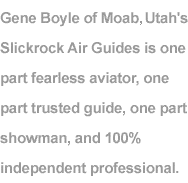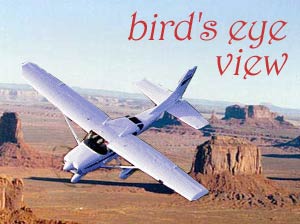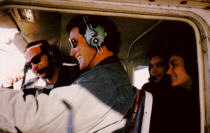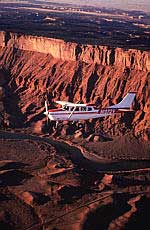 |
|
||||||||||||

|

Want a moving experience? Click here if you're patient. |
|
By Michelle Sullivan
|
"I really do like to romance my product," says Gene Boyle, the one and only pilot at Slickrock Air Guides of Moab, Utah. When people visit the American west, he says, "national parks are the number one attraction, and cowboys and Indians come next." Boyle's airborne tours blend fabulous scenery, regional history, and a few surprises to meet tourists' top requests. "The demand of meeting expectations, if not exceeding them, is always a challenge," says Boyle. Slickrock's turf, which includes Canyonlands National Park, Monument Valley, Lake Powell, and the Grand Canyon, is some of the most stunning real estate on the planet, and you might expect Boyle to rely simply on breathtaking aerial views to satisfy his customers. Guess again. "You're not getting an airplane flight," Boyle explains. "You're getting a tour with someone who is passionate about the area, and you're getting more info than you could any other way." In case the scenery isn't enough, Boyle is always ready to stray from the flight plan. One tour includes an (unadvertised) visit to the mud-covered hogan of a Navajo woman who contributes her people's point of view to Boyle's narration of local history. Another tour visits an old Native American bridge that spans the Grand Canyon (also not mentioned in Slickrock's brochure).
When Boyle moved to Moab from Park City in 1984, he began working as a river rafting guide. Two years later, he set aside the time and money to realize a longtime personal ambition by learning to fly. He took to it immediately, and as soon as he had amassed enough flight hours to pass the requirements for both commercial and carrier licenses, he launched Slickrock Air Guides as a hobby. The hobby became a business in 1993, and Boyle has been conducting scenic and charter flights throughout southern Utah and northern Arizona ever since. During the flying season, which runs roughly from mid-May to mid-October, Boyle stays busy with what he calls "the operational end of the business" -- flying. He can spend as many as eight hours a day in the air. (Appropriately, he charges by the hour: $79 per person for a one-hour tour; $159 per person for two hours; and $255 per person for a half-day.) During these months, Boyle is in constant motion. Pre-scheduled flights depart as early as seven in the morning. When the air is smooth, Boyle flies all morning -- one-, two-, and five-hour tours, and charter flights to regional airports. Paperwork, both the usual business-related scribblings and the extensive record-keeping required by the FAA, fill Boyle's early afternoon hours, effectively barring unexpected tour requests. Then, before sunset, he takes to the air for a final flight. Building Business In the off-season, Boyle concentrates on marketing. He maintains a website and keeps regional visitor centers stocked with an eye-catching three-color brochure, but promotes his business primarily by building relationships with other tourist-oriented businesspeople in the Moab area and abroad. Gene Goes to Europe A substantial number of Boyle's customers are Europeans who find him through European tour operators. Every year, therefore, Boyle goes to Europe with a group of local bike and rafting guides to meet with tour operators who will be bringing tourist groups to the U.S. the following summer. These tour companies account for about 40% of Boyle's business, a share that he expects to grow in the years to come. "There are lots of these tour operators over there, and if you put out the initial effort and the marketing money to make connections, they will stick with you," says Boyle, emphasizing the importance of his international business. He enjoys strong relationships with the tour operators, who prefer to use a guide they know and trust than to have to shop around before every trip. "They won't break off your relationship just because someone comes along and offers them a lowball price," Boyle says. The trips to Europe have not only increased Boyle's business, he says, but also improved his tours. "I see what their culture is like, and I can really appreciate their awe at seeing the west." Local Connections In addition to the European tour companies, local hotel and restaurant owners account for a large slice of Boyle's business, so he makes an effort to know the ones in his community and to tell them about his services. "In a small community like this one, your best marketing tool is other business owners," he says. "If you're a contributor in the community, they'll be comfortable sending guests to you." As a volunteer for Utah's Superhost program, which by law requires communities with tourist economies to train service workers, Boyle teaches hotel desk clerks (for example) how to create Disney-style magic by going beyond mere helpfulness. "We have to represent the community as a whole," he says. "If we want people to visit, service [needs to be] our number one priority." Boyle's work for the Superhost program yields incidental benefits for his own business, too: first, the local tourist professionals who get to know him subsequently recommend Slickrock, and second, Boyle increases the likelihood that his guests will enjoy themselves even when they're not with him. Trust Me Trusting someone with your vacation is one thing; trusting someone with your life is another. Boyle estimates that half of the traveling populace is afraid of small airplanes. "I'm hit with every kind of question from people trying to qualify me," he says. Boyle answers these questions with genial confidence. "When people meet you, they have to see your self-confidence. Just the way you walk up to them or address them in the first moment relieves a lot of anxiety." Boyle admits that bearing the weight of his passengers' fears can be stressful, but he also knows that they would have a lot more to fear if he let the stress get to him. "If you kept your mind focused on [the anxiety people feel about flying], you'd go crazy. You have to blow it off." It's easy for Boyle to feel confident in the safety of his aircraft, because he doesn't believe in skimping on equipment or repairs -- even if the expenses themselves are a source of stress. ("Airplanes are extremely expensive pieces of machinery," he says, recalling the bank loan that allowed him to buy his current six-seater.) He knows that cost-cutting wouldn't be prudent in the long run. Moreover, despite a growing familiarity with his machines, Boyle relies on trained mechanics for all major repairs. "Even though I can assist, I want professionally trained eyes to look at my planes, to give me that extra level of assurance."
Furthermore, Boyle makes personal training a year-round priority. According to FAA [Federal Aviation Administration] regulation, he schedules biannual checkups with a district FAA official, who ensures that Slickrock is in compliance with the agency's standards. Once a year, the same official gets a spin in Boyle's plane so he can see Boyle and the equipment in action together. Boyle also sets time aside each year to test his flying skills in simulators at a Salt Lake City testing site. The simulators approximate the experience of flying planes that are larger than Boyle's Cessna, and Boyle believes that the variety "makes you a much more in-tune pilot." As Boyle puts it, "I'm constantly doing my homework." Back in Moab, Boyle bounces ideas off of his closest confidante and business advisor -- wife Sheri Griffith, who owns a river-rafting outfit called Sheri Griffith Expeditions. She understands the business of creating unforgettable vacations, and each partner offers the other the kind of support many IPs crave. Boyle provides charter flights for many of Griffith's rafting clients and, in return, Griffith's staff takes phone reservations for Boyle. In the end, Boyle and Griffith show that alliances aren't just for big businesses, and that running a small business can be as much fun as... well... taking a vacation. | ||||
| |||||
|
September 4, 1999 Edited by Eric Gershon Production by Keith Gendel |
We'd love to hear your comments about this article! Michelle Sullivan is a former Editor-in-Chief of Let's Go travel guides. This is her first article for 1099. If you like, we'd be happy to put you in touch with her, or with anyone named in this article. | ||||
|
| |||||
The 1099 name and logo are trademarks of 1099 Magazine.

